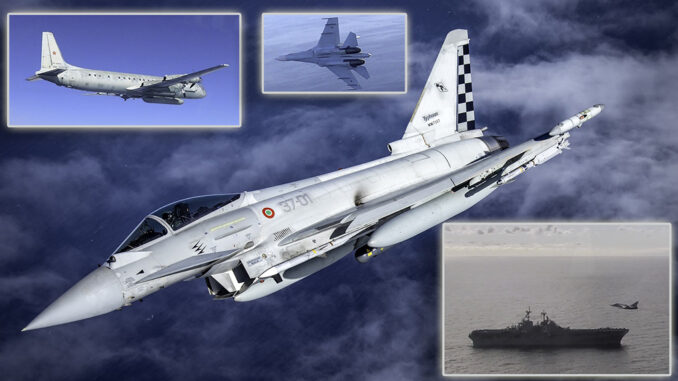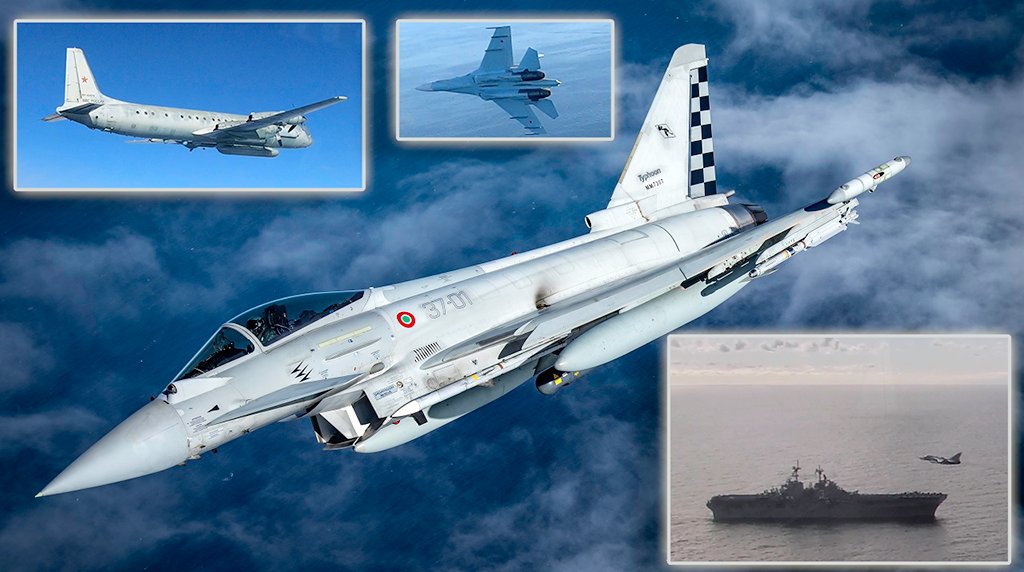[ad_1]

The Italian Eurofighters deployed to Poland have carried out 16 alert scrambles to intercept 19 Russian combat aircraft in the last few weeks. An “impressive number” according to the commander of the Italian Task Force.
Eight Alpha Scrambles (alert departures) in just one week, the last of those in the morning on Oct. 6, 2022, for a total of 16 in the last two months: these are the “numbers” of the TFA (Task Force Air) “White Eagle”, the Italian Air Force Eurofighter Typhoon detachment supporting NATO’s eAP (enahnced Air Policing) mission in Poland.
Four F-2000A (as the single seater Typhoons are designated by the Italian MOD) of the Aeronautica Militare (ItAF) have arrived in Malbork on Jul. 28, 2022. The aircraft and personnel are pooled from all the units operating the Eurofighter within the ItAF [the 4th, 36th, 37th and 51st Stormo (Wing)] and supported, when and if needed, by other assets also made available by the service, such as the KC-767A tanker and transport aircraft and the G550 CAEW (Conformal Airborne Early Warning), both belonging to the 14° Stormo from Pratica di Mare airbase.
Their role is to strenghten the deterrence posture on the northeastern flank of NATO airspace as well as to ensure the integrity and security of the Polish airspace and of all the countries of the Alliance, while maintaining a strategic flexibility to quickly intervene in other areas, should the need arise.
The operational activity, which takes place on a daily basis often sees the Italian Typhoon carry out joint activity with the MiG-29 aircraft of the Polish Air Force also based at Malbork.
“Here in Poland the activity is intense, on the other hand, all these intrusions or approaches to the NATO airspace by Russian aircraft, albeit always remaining on portions of international waters, is unprecedented here. However, we remain calm because we are prepared to do our job. And morale is high” told the Adnkronos news agency Col. Salvatore Florio, the commander of TFA “White Eagle”.
“We fly at least twice a day for a total of more than 40 hours real operational interception, which adds up to over 250
operational hours during those we have flown in the Polish skies or over international waters within the boundaries of the Polish airspace,” Florio said.
Before deploying to Malbork to support eAP from Poland for the first time, the Italian Air Force’s Typhoons completed NATO’s eAPA-S (Enhanced Air Policing Area South) mission in Romania. Initially supposed to last only four months, the mission lasted for seven months and was completed on July 1, 2022. This was due to NATO’s response to Russian actions in Ukraine, which also led to the Italian detachment doubling the number of deployed aircraft, bringing the total to eight Typhoons.
But it looks like the Russian activity the Italians are observing in the Baltics is well above the one they have seen during the previous deployments, as proved by the 16 scrambles launched by the ItAF Eurofighters from Malbork so far: “An impressive number” Florio told the ANSA news agency. “The number of [Russian] incursions [inside the Polish and Swedish FIRs] is intensifying […] Sometimes the Russians are more cooperative, in other cases they are less, but we are careful and try to avoid any kind of misunderstanding, and de-escalate the situation” Florio said according to ANSA.
Overall, according to our sources, the Italians have identified 19 Russian Aerospace Forces and Russian Navy aircraft, since they have deployed to Poland. The first images of the “zombies” were released by the Aeronautica Militare on Sept. 22, 2022 and showed a Su-24 Fencer, but among the Russian aircraft shadowed by the Italian Typhoons over the last few weeks there are also Su-27s, Su-30s and some Il-20 spyplanes.
Finally, an image of a zombie has been released: Russian Su-24M with KH-25ML missile intercepted over the Baltic Sea. https://t.co/pWQoiy6eob
— David Cenciotti (@cencio4) September 22, 2022
More recently, the service has also released some footage that shows some of the close encounters with the Russians that you can see here below. Interestingly, among all the other things, you can also see the Italians shadowing at least one Russian Navy Su-24M Fencer flying quite close to U.S. Navy Wasp-class amphibious assault ship USS Kearsarge (LHD-3) in the Baltic Sea.
[ad_2]
Source link
